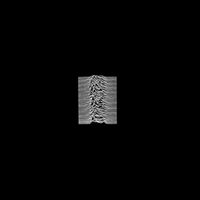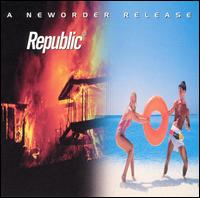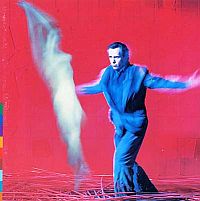Ryuichi Sakamoto: Jack of All Trades, and Master of All
From the early, pioneering days with avant-rockers Yellow Magic Orchestra (during which he virtually set the blueprint for the emerging techno-pop movement), to the grandiose but measured orchestrations he did for cinematic epics like 'The Last Emperor' and 'Little Buddha', to the latter-day experiments in modern classical, Sakamoto can well and truly be called "a careerist who lives on the cutting edge" (as described in Time magazine's profile of him in their 2002 'Asian Heroes' issue).
Here are some of the more prominent recordings that Sakamoto has made in his three-decade-plus residency in the business:
THOUSAND KNIVES (1978)
Sakamoto's debut solo effort is an intelligent updating of his works with Y.M.O., highly reminiscent of Kraftwerk's middle-period endeavours. A milestone album that signalled the beginning of a new trend in Japanese techno-pop.
THE END OF ASIA (1982)
A singularly unique work combining classical gagaku tonalities with Renaissance-era textures, Sakamoto's collaboration with the early-music ensemble Danceries is a breathtaking, complex yet accessible album remains the most adventurous in his repertoire.
MERRY CHRISTMAS MR. LAWRENCE (1983)
Sakamoto's soundtrack for Nagisa Oshima's existentialist drama, aptly displaying the inventive pentatonic arrangements that he would soon be known for. A purely synth-derived effort that remains surprisingly undated and engaging, even after more than two decades after its initial release.
ILLUSTRATED MUSICAL ENCYCLOPEDIA (1984)
Arguably Sakamoto's most eclectic album, this sprawling work takes in everything from straight-ahead synth-pop ("Field Work", featuring synth maestro Thomas Dolby), to austere minimalism ("M.A.Y. in the Backyard"), to electronically based fusion jazz ("Etude") and Oriental dub ("In a Forest of Feathers"). Might sound uneven at times by virtue of its stylistic variety, but still remains Sakamoto's most adventurous venture.
NEO GEO (1987)
A more streamlined version of "Illustrated Musical Encyclopedia" that incorporates large doses of funk into its structure. Notable for appearances by Booty Collins and Bill Laswell, and including "Risky", a startling techno-pop duet with punk godfather Iggy Pop, of all people.
THE LAST EMPEROR (1987)
Sakamoto's lavish score for the Bernardo Bertolucci epic that earned him an Oscar. A staid, expansive suite that makes wonderful use of romantic-era motifs, Ching-dynasty musical themes and Sakamoto's own distinct timbral sensibilities, and a landmark in modern classicism.
HEARTBEAT (1991)
Essentially Sakamoto's contribution to the then-burgeoning house movement, with some avant-pop aesthetics. A controlled artistic experiment that merges Parisian swing, Hendrix samples, proto-ambient patterns, ethnic fusion and disco glitz. A genre-defying woldbeat melange.
SWEET REVENGE (1994)
In which Sakamoto visits the New York underground club scene and comes away with appropriate-sounding collaborations with Roddy Frame, Andy Caine, Paul Alexander and Holly Johnson. Some tracks are hard-edged (the brutal techno-pop workout "Love and Hate") and stately (the minimalist title track), others dreamy (the free-flowing "Interruptions") and placid (the soothing "Water's Edge").
1996 (1996)
A serious, studied chamber-orchestral work that brilliantly displays Sakamoto's modern-classical arranging aptitude. Past themes from "The Last Emperor", "The Sheltering Sky" and "Merry Christmas Mr. Lawrence" are given new, vibrant life in this elegant, sophisticated setting.
SMOOCHY (1997)
Sakamoto's most carefree album integrates neo-bossa nova ("Bibo no Aozora"), post-romanticism ("Bring Them Home"), late-1970s Miles Davis ("Insensatez") and modified reggaeton ("Poesia"). However, tarnished by an appalling album design.
DISCORD (1998)
A thematic neo-classical symphony about the state of the late-millennium world that is largely influenced by timbral chromaticism and harmonic atonality. Soberly ascetic, yet animated at the right moments, this is akin to locking Stravinsky, Schoenberg and Gorecki in a small room, and forcing them to come up with an experimental soundscape that sets free their innermost inhibitions.
BTTB (2001)
Back to the basics, indeed. A minimalist solo-piano showcase that is also informed by post-romantic motifs from Ravel, Satie and Debussy, this is an avowedly avant-garde, painfully perfectionist recording that is like a vanity project for Sakamoto's pianistic dexterity and range. Look out for a John Cage-influenced prepared-piano piece that is a marvellous study in tasteful dissonance.
CASA (2002)
"Lush" and "melodic" are the two words that come to mind when describing this refined, poised tribute to bossa-nova legend Antonio Carlos Jobim. Aided by longtime Jobim partners Jaques and Paula Morelenbaum, Sakamoto interprets a selection of well-known Jobim gems ("O Amor em Paz", "Vivo Sonhando", "Inútil Paisagem") and other less-celebrated tunes ("Chanson pour Michelle", "Tema para Ana"). An all-round artistic triumph for all concerned.













